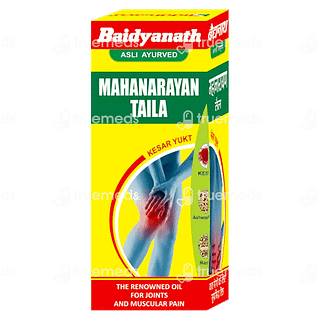Why Joint Pain Increases in Winter and How to Manage It
Last updated on : 04 Apr, 2025
Read time : 19 min
As the winter months approach, many individuals experience an increase in joint pain, a phenomenon that is more than just a casual observation. This seasonal exacerbation of joint discomfort can be attributed to several factors, affecting both those with pre-existing joint conditions and those without. Understanding these factors is crucial for managing and alleviating winter-induced joint pain.
Why Are Joints More Painful in the Winter?
The winter season brings a combination of environmental and physiological changes that can exacerbate joint pain. Several key factors contribute to this increased discomfort. Let’s delve into each of these factors in more detail.
1. Drop in Temperature
The drop in temperature during winter can have a significant impact on joint pain. Here’s how:
- Cooler temperatures can cause the synovial fluid in joints to thicken, reducing its ability to lubricate and cushion joints effectively, leading to increased stiffness and pain.
- The cold can also cause muscles, ligaments, and tendons to tighten, reducing their flexibility and putting additional pressure on the joints.
2. Reduced Blood Circulation
Reduced blood circulation is another factor that can exacerbate joint pain during the winter. Here’s what happens:
- Cold weather leads to the constriction of blood vessels and nerves, reducing blood flow and circulation to the extremities. This decrease in circulation can increase stiffness and pain in the joints.
- Lower blood supply to the joints can exacerbate existing joint conditions, such as arthritis, by reducing the delivery of nutrients and oxygen to the joint tissues.
3. Barometric Pressure Changes
Changes in barometric pressure, common during cold weather, can also contribute to joint pain. Here’s how:
- Drops in barometric pressure can cause tissues in the body to expand. This expansion can compress joints, leading to pain and stiffness, especially in those with arthritis.
- Even minor increases in swelling within the confined spaces of joints can be felt more intensely due to the changes in barometric pressure.
4. Reduced Physical Activity
Cold weather often leads to reduced physical activity as people prefer to stay indoors. This lack of exercise can have a negative impact on joint health.
- A reduction in physical activity can lead to weakened muscles and reduced joint flexibility, contributing to increased joint pain.
- Lack of exercise during the winter months can also result in dehydration, as the body pulls water from various sources, including joint cartilage, further exacerbating joint stiffness and pain.
Common Symptoms of Winter Joint Pain
During the colder months, individuals with joint conditions may experience an exacerbation of their symptoms. Some of the most common signs of winter joint pain include:
- Stiffness and aches in the joints, particularly after periods of inactivity or exposure to cold temperatures
- Reduced mobility, making everyday activities more challenging
- Swelling and inflammation in the joints due to changes in barometric pressure and cold weather
- Muscle weakness around the joints, resulting from reduced physical activity during winter
- Increased sensitivity to pain, as dehydration and cold weather can make joints feel more painful than usual
Tips to Manage and Prevent Joint Pain in Winter
Winter can be a challenging time for those who suffer from joint pain. However, there are several ways to manage and prevent joint pain during the winter months.
1. Eat Healthy
A healthy diet is essential for managing joint pain in winter. Consuming foods that are rich in anti-inflammatory properties can help reduce swelling and discomfort in your joints. Some examples of these foods include fatty fish like salmon, nuts and seeds, and fruits and vegetables. It is also important to avoid processed foods and sugary drinks, as these can contribute to inflammation in the body.
2. Stay Active
While it may be tempting to stay indoors and avoid exercise during the winter months, staying active is crucial for managing joint pain. Low-impact exercises like swimming, cycling, and yoga can help keep your joints flexible and your muscles strong without putting too much strain on your body. If the weather is too cold to exercise outdoors, consider joining a gym or taking a fitness class. Regular physical activity can help improve your overall health and reduce the severity of your joint pain. To learn more about the importance of hydration and its role in overall health, explore How Much Water Should I Drink a Day? Benefits and Tips.
3. Stay Hydrated
Staying hydrated is important for overall health, but it is especially crucial for those with joint pain. When you are dehydrated, your body may pull fluid from your joints, leading to stiffness and discomfort. Aim to drink at least eight glasses of water per day and avoid sugary drinks and alcohol, which can contribute to dehydration. If you find it difficult to drink plain water, try adding slices of lemon or lime for flavour.
4. Get a Massage
Massage therapy can be an effective way to manage joint pain in winter. Massages can help improve circulation, reduce muscle tension, and alleviate stress and anxiety, all of which can contribute to joint discomfort. If you are unable to visit a massage therapist, consider using a foam roller or massage ball to work out any knots or tensions in your muscles.
5. Use Hot Packs
Applying heat to your joints can help alleviate pain and stiffness, especially during the winter months. Hot packs, heating pads, and warm baths can all be effective ways to soothe sore joints. The heat helps to increase blood flow to the affected area, which can reduce inflammation and promote healing. Be sure to use caution when applying heat, and never leave a heating pad on for too long, as this can cause burns or skin irritation.
6. Take Medications
If your joint pain is severe or persistent, your doctor may recommend taking medication to manage your symptoms. Over-the-counter pain relievers like ibuprofen or acetaminophen can be effective for mild to moderate joint pain. If your pain is more severe, your doctor may prescribe a stronger medication or recommend a topical cream or gel. It is important to follow your doctor’s instructions carefully and never take more medication than recommended. For additional tips, explore Home Remedies for Joint Pain to manage discomfort naturally.
1. Miduty Joint Pain Relief Capsule
Miduty Joint Pain Relief Capsule is used for providing essential support to joints, particularly in managing arthritis symptoms, joint swelling, back pain and knee discomfort.
How to Use
Take one capsule after breakfast and one after lunch with water, or as prescribed by a healthcare professional.
In the summer, those who have problems with items that are hot in nature can take one capsule daily.
2. Dr Reckeweg R73 Drops 22ml
Dr Reckeweg R73 Joint Pain Drops are used for supporting joint health and providing comfort from pain. Its natural ingredients are designed to support the knees, hips and vertebrae, focusing on promoting joint flexibility and easing discomfort associated with various joint conditions.
How to Use
- Refer to the product label for detailed instructions on usage.
- Consult a qualified homoeopathic practitioner for personalised guidance.
| Quick Recipe: Turmeric and Ginger Anti-Inflammatory Smoothie: Blend one banana, a handful of spinach, and half a cup of yoghurt. Add one teaspoon of grated fresh ginger and one teaspoon of ground turmeric for their anti-inflammatory properties. Pour in a cup of almond milk and a tablespoon of honey for sweetness. Blend until smooth and creamy. This vibrant smoothie is not only delicious but also packed with nutrients to help reduce joint pain and inflammation. Enjoy chilled! |
3. Radient Joint Pains Drops
Radient #06 Joint Pains Drops is a homoeopathic formulation that is used for arthritis, stiffness of joints, and swelling of Joints.
How to Use
- Take 8 to 10 drops in 2 spoons of water three times a day or as prescribed by the doctor
4. Zandu Ortho Vedic Knee and Joint Pain
Zandu Ortho Vedic Knee and Joint Pain Oil is used for managing joint and muscle pain.
How to Use
- Spread out 5-10 ml of the oil on the inflamed area and gently massage for a few minutes.
- Use twice daily in case of severe pain.
- Repeat as often as required.
5. Baidyanath Mahanarayan Tel
Baidyanath Mahanarayan Tel Joint Pain Oil 200 ML is used for relieving joint and muscle pain It may help strengthen bones, muscles and nerves.
How to Use
- Spread out 5-10 ml of the oil on the inflamed area and gently massage for a few minutes.
- Use twice daily in case of severe pain.
- Repeat as often as required.
6. Wholeleaf Muscle & Joint Pain Rub Oil
Wholeleaf Muscle & Joint Pain Rub Oil is designed to provide relief from joint pain, muscle soreness, stiffness, and inflammation-related discomfort.
How to Use:
- Apply a thin layer to the affected area and massage gently for a few minutes until absorbed.
- Use 2-3 times daily or as recommended by your doctor.
- Regular use can help reduce discomfort and enhance mobility.
7. Imbue Niraama Joint Pain Relief Oil
Imbue Niraama Joint Pain Relief Oil is a unique natural blend of anti-inflammatory, muscle-relaxing, and soothing herbal ingredients.
How to Use:
- Apply 5-10 ml of the oil to the affected area and massage gently for a few minutes.
- For severe pain, use twice daily.
- Reapply as needed for continued relief.
When to Seek Medical Help for Joint Pain
While many instances of winter joint pain can be managed at home, there are certain situations in which it is advisable to consult a doctor. If you experience persistent swelling, redness, or warmth in your joints, it could indicate an underlying infection or severe inflammation that requires medical attention. Additionally, if you find it challenging to put pressure on or use the affected joint, or if your joint pain is severe and interferes with your daily activities, it is important to discuss potential treatments or therapies with your doctor.
Conclusion
In conclusion, joint pain during the winter months is a prevalent issue that many people face. Several factors contribute to this increased discomfort, such as changes in barometric pressure, thickening of synovial fluid, constriction of blood vessels, and reduced physical activity. To effectively manage joint pain during the colder months, it is essential to adopt a warm and active lifestyle. If you experience persistent or severe joint pain, it is advisable to consult your doctor for a personalised treatment plan tailored to your specific needs.
Frequently Asked Questions (FAQs)
To alleviate winter joint pain, maintain a healthy weight, eat an anti-inflammatory diet, stay active with indoor exercises, keep warm, and use heat therapy like heating pads or warm baths.
Joints are more painful in cold weather due to changes in barometric pressure, which cause tendons, muscles, and surrounding tissues to expand, leading to increased pressure and discomfort.
While having a cold itself does not directly cause joint pain, the associated lack of physical activity, potential dehydration, and changes in mood can exacerbate existing joint conditions like arthritis.
To reduce body pain in cold weather, dress warmly, stay hydrated, maintain a balanced diet rich in anti-inflammatory foods, and engage in regular physical activity to keep muscles and joints mobile.
Treat body pain from cold weather by applying heat to affected areas, staying active with low-impact exercises, managing weight, and considering over-the-counter medications like NSAIDs or paracetamol.
Stay active during winter by choosing indoor exercises such as walking in malls, using an elliptical trainer, swimming in heated pools, and incorporating stretching routines like yoga or tai chi.
Joints most affected by winter pain include the knees, hips, and back, particularly in individuals with conditions like arthritis or chronic pain.
While joint pain in winter cannot be completely prevented, it can be significantly managed through maintaining a healthy weight, eating well, staying active, keeping warm, and using heat therapy.
References
- https://pubmed.ncbi.nlm.nih.gov/26329341/
- https://pubmed.ncbi.nlm.nih.gov/27633622/
- https://pubmed.ncbi.nlm.nih.gov/38229817/
- https://www.researchgate.net/publication/311393543_Effect_of_Cold_Weather_on_the_Symptoms_of_Arthritic_Disease_A_Review_of_the_Literature
- https://health.clevelandclinic.org/barometric-pressure-joint-pain
Disclaimer
Our healthcare experts have carefully reviewed and compiled the information presented here to ensure accuracy and trustworthiness. It is important to note that this information serves as a general overview of the topic and is for informational purposes only. It is not intended to diagnose, prevent, or cure any health problem. This page does not establish a doctor-patient relationship, nor does it replace the advice or consultation of a registered medical practitioner. We recommend seeking guidance from your registered medical practitioner for any questions or concerns regarding your medical condition.
Popular Articles
Recommended Articles
Recent Articles
Top-Selling Medicines:
...View more
Top-Selling OTC:
...View more
Subscribe
Registered Office Address
Grievance Officer
Download Truemeds

Contact Us
Our customer representative team is available 7 days a week from 9 am - 9 pm.
v3.7.5
Our Payment Partners





























































